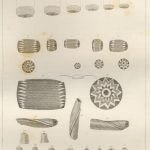
The discovery of America caused a total revolution in the standard of value among the Indian tribes. Exchanges among them had been adjusted to a great extent, by articles in kind. Among the northern tribes, skins appear to have been a standard. A beaver skin long continued to be the plus, or multiple of value. But however general this standard might have been, it is certain that among the tribes seated along the north Atlantic, some varieties, or parts of species of sea-shells, under the names of peag, seawan, and wampum, became a sort of currency, and had the definite arithmetical value of coin. In New England a string of wampum consisted of a definite number of grains, the whole of which was worth five shillings. At Manhattan and Fort Orange, it appears from ancient documents on file in the State Department at Albany, as stated by Dr. O’Calligan, that about 1640, three beads of purple or blue wampum, and six of white wampum, were equivalent to a styver, or to one penny English. It required four hundred and fifty beads to make a strand, which was consequently valued at $ 1.50. At a subsequent period, four grains of sewan made a penny. Purple wampum was made from the Venus mercatorius, while the white was taken from the pillar of the periwinkle.
In opening ancient graves in Western New York, this ancient coin has been found in the shape of shell-beads, some of which are half an inch in diameter. The same article has been disclosed by the tumuli, and graves of the West. It has also been taken from the plains of Sandusky, and from the locations of Indian graves near Buffalo, and north of the Niagara River in Canada. It is at these localities precisely the same article. Not less than seventeen hundred of this shell coin were taken from a single vault in a tumulus in Western Virginia. It has sometimes been improperly called “ivory” and “bone.” It is of a limy whiteness and feel, from the decomposition of the surface, and requires care to determine its character. But in every instance it is found to yield a nucleus of shell.
Figures 1, 2, 3, 4, 5, 6, Plate 24, in the subjoined print, exhibit this article in its several sizes.
